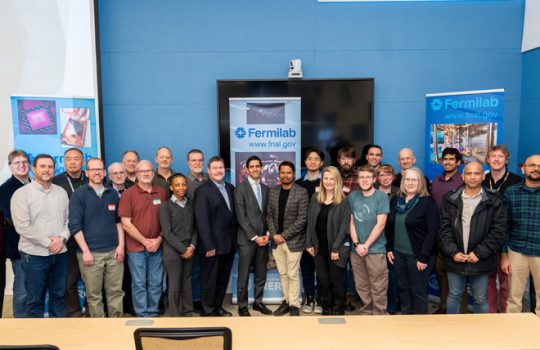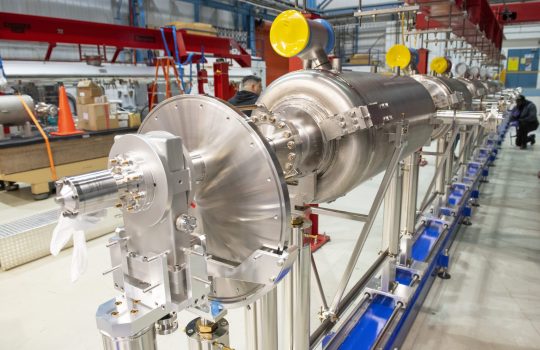
Charles Thangaraj holds a model of the compact accelerator he recently received a grant to develop. Photo: Reidar Hahn
Fermilab scientist Jayakar ‘Charles’ Thangaraj has been awarded $200,000 from the Accelerator Stewardship Program of the U.S. Department of Energy to develop the design of a new, compact high-power accelerator. Collaborators are conceptualizing the potential use of this electron accelerator, based on superconducting radio-frequency (SRF) technology, in treating municipal biosolids and wastewater in collaboration with the Metropolitan Water Reclamation District (MWRD) of Greater Chicago.
The grant builds on the previous work conducted by a team at the Illinois Accelerator Research Center (IARC) at Fermilab, specifically the work to design a one-megawatt electron accelerator – toward the top end of typical industrial electron accelerator power.
The results of simulations from that initial effort were encouraging enough that the IARC team proposed an accelerator system with a truly revolutionary 10-megawatt power output.
“Our simulations gave us positive results and encouraged us to pursue a higher-powered machine,” said Thangaraj, who is the science and technology manager at IARC. “I am thrilled to hear this proposal was awarded, we are ready to investigate.”
Municipal biosolids produced at MWRD’s water reclamation plants are generated through processes to remove larger, suspended solids from the water and organic pollutants, as well as to physically or chemically kill pathogens. In the Chicago area, treated water is then allowed to flow into local waterways without risk of harming the ecosystem. The byproducts from the water reclamation process are further treated to recover nutrients and energy and converted into a final product as biosolids that are beneficially used as fertilizer or soil amendment.
With an electron accelerator, the flowing water is exposed to a beam of highly energetic electrons, which create radicals in the solution that can disrupt chemical bonds. This will help kill pathogens in the water and the biosolids and increase the efficiency of recovering energy and nutrients from the biosolids.
This electron beam treatment technique has a few advantages. Firstly, because the treatment technique is physical and involves only a burst of electrons, the need for possibly harmful additional chemicals can be eliminated. Commonly used chemicals for inactivating pathogens in water, such as chlorine and ozone, can leave further residuals in the water, can be expensive to produce, or require filtration to avoid toxicity to workers at treatment centers.
Further, the technique can destroy organic contamination and pharmaceuticals that might otherwise survive conventional treatment.
While chemical and biological treatment processes require carefully controlled conditions and target specific contaminants, electron beam treatment is broadly effective and requires only an electricity supply to run.
The treatment process is also rapid, able to handle chemical and biological hazards simultaneously, and especially with the increased portability of this new conceptual design from IARC, easily adaptable to existing plant designs and layouts.
Accelerators for social impact
Fermilab’s mission is to build and operate world-class particle physics facilities for discovery science. In building such high-precision physics machines, the technologies that are developed can also have an impact on U.S. industry and wider society. IARC’s complementary mission is to take cutting-edge inventions from the lab and adopt those into real-life products and solutions. The IARC compact accelerator is a case in point.
“IARC’s compact SRF accelerator is a pioneer in the industrial accelerator space,” Thangaraj said.
Several Fermilab-developed technologies are combined to build this novel accelerator, and the platform technology has a range of potential applications, including extending the longevity of pavements and medical sterilization.
New innovations
SRF accelerators, including those currently used at Fermilab, rely on being cooled down to around 2 Kelvin, colder than the 2.7 Kelvin (minus 270.5 degrees Celsius) of outer space. The components need to operate at cold temperatures to be able to superconduct: the ‘S’ in SRF. The typical way to do this is by immersing the cavities in liquid helium and pumping on the helium to lower its pressure. However, producing and maintaining subatmospheric liquid helium requires complex cryogenic plants – a factor that severely limits the portability and therefore the potential applications of SRF accelerators in industrial environments.
“We are able to do away with liquid helium through a combination of recent advancements in superconducting surface science and cryogenics technology. This allows us to operate at a higher superconducting temperature in our cavities and cool them in a novel way,” said Thangaraj, who was also awarded $1.47 million to develop this crucial Fermilab-patented technology from the Laboratory Directed Research Development program.
“Breaking the need for a supply of liquid helium makes the accelerator very attractive for installation within MWRD’s existing infrastructure,” he said.
Though such real-life solutions are exciting and promising, the reality remains a few years away. Nevertheless, IARC has already started talking to several stakeholders in the industry.
“When we turn the tap or twist open a bottle, we often don’t realize that behind such modern conveniences are some of the most amazing technologies that deliver clean and safe water,” Thangaraj said. “Water is such a precious resource on our planet. We must use our best technologies to protect it. Electron beam technology could be a practical and effective way for water treatment in the future. Now is the time to develop it.”



